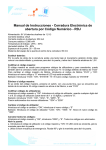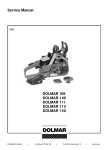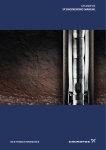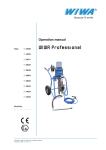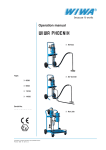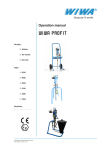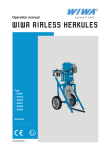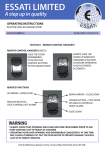Download Service Manual
Transcript
Service Manual 1/94 PS-340, 341 PS-400, 401 1 Index Index Technical data page 3 Special tools 4 01 Chain brake 5 02 Clutch, clutch drum 5 03 Oil pump 6 04 Ignition system 8 05 Starting system 10 06 Carburettor, intake system 11 07 Deko-Valve 12 08 Vibration damping system 13 09 Fuel tank 13 10 Cylinder, piston 14 11 Crankcase, crankshaft 14 12 Checking operations 16 Torques 17 2 Technical data Model PS-340/341 PS-400/401 Displacement 3 cm 33 39 39 Bore mm 37 40 40 Stroke mm 31 31 31 Rating kW 1,4 1,7 1,7 2600 2600 2600 11500 12000 12000 Idling rpms Allowed max engine speed with bar and chain 1/min Gap Flywheel / Coil L r.p.m. H r.p.m. Max. mm High tension wire legth Spark plug NGK 0,2 0,2 0,2 mm 300 300 BPMR-6F BPMR-6F BPMR-6F RDJ-7Y RDJ-7Y CHAMPION Elektrode gap mm 0,5 0,5 0,5 Fuel tank capacity Ltr. 0,4 0,4 0,4 0,25 0,25 0,25 1/1 1/1 1/1 mm 3 / 900 3 / 900 Oil tank capacity Ltr. Carb. adjustement Starter rope L/H S H L ø / length Saw chain Terms / Pitch 092 092 092 Low Profil Low Profil Low Profil 300 RDJ-7Y 3 / 900 Cutter type Semi chisel Gauge 3/8 (9,52) 0.50 (1,3) 30° 3/8 (9,52) 0.50 (1,3) 30° Sideplate Angle 85° 85° 85° Cutting Angle 60° 60° 60° 90° 90° 90° mm 0,65 0,65 mm 4,0 4,0 1 2 Filing Angle 90° File Guide Angle Depth Gage Setting File ø Kick back Reduction Cutting length Drive Link Sprocket Semi chisel Semi chisel 3/8 (9,52) 0.50 (1,3) Drive Link inch mm inch mm 10° Depth Gauge / Depth Gauge / Bumper Tie Strap Bumper Tie Strap cm Count No of Teeth type 35/40 35/40 52/56 6 Rim (fixed) 52/56 6 Rim (fixed) Bumper Tie Strap 3 Special tools Puller for oil seals 944 500 870 4 Mounting sleeve for radial rings 944 500 540 Sealing plate for leakage test of crankcase 944 603 020 / 944 603 030 Drift for piston pin Dis- and mounting tools for drive worm of oil pump 950 500 020 Jarring blow punch 944 603 250 944 500 880 Setting gauge for ignition armature 944 500 890 Mounting tools for clutch hub 944 500 690 01 Chain brake 02 Clutch, clutch drum 2 3 1 4 01-02 Replacing the brake band Remove the sprocket guard from the engine unit. Release the chain brake by pushing the lever in direction of the arrow. Unsrew the five srews and remove the protection plate (1). 01-02 Replacing the brake band Lift brake band out of the sprocket guard (2) and of the hook (3). When fitting a brake band ensure that the guide piece (4) is installed correctly in the slot of the sprocket guard. 6 5 7 02-01 Removing the clutch and clutch drum Block the cylinder unit before removing the clutch drum or clutch. For this purpose unscrew the muffler (5) and pass the piston stopp wedge (6) 944 602 001 into the exhaust duct of the cylinder. 7 8 02-01 Unscrewing the clutch To unscrew the clutch use spanner (8) no. 944 500 690. Caution: Left-hand thread. If required, the clutch springs (7) have to be replaced as a complete set. 9 02-03 Checking the clutch drum/sprocket Clean or renew in the case of contamination or wear. 02-04 Mounting the clutch drum Lightly grease the needle bearing (9) prior to installation. Tighten the clutch using a torque of 25 Nm. 5 03 Oil pump 1 + 03-01 Adjusting the oil pump delivery Adjustment is by turning the screw clockwise = less chain oil anti-clockwise = more chain oil. + 2 03-02 Dismantling the oil pump Slightly raise the claws from the chain guide plate (1) and remove the guide plate and the chain tensioner (2). 3 13 12 03-02 Removing the oil pump Pull out the oil pump from the crank case and from the suction line (3). 4 03-02 Mounting the oil pump When mounting the oil pump, the pin (12) must be inserted into the hole (13). 7 7 5 6 03-03 Inspecting the oil pump Remove the retaining ring and the washer (4). Remove the set screw (5). Remove the oil pump plunger (6) together with the compression spring from the housing (7). 6 03-03 Assembling the oil pump Prior to reassembling the oil pump, liberally grease the oil pump plunger (6) and the housing (7) with silicon compound no. 980 007 100. 03 Oil pump 3 9 8 8 03-04 Checking the intake line and the filter Withdraw the intake line (3) from the crankcase. Remove the filter (8) from the intake line for cleaning. 03-04 Greasing the suction line Prior to the installation of the suction line grease the line in way of the sealing face (9) at the crankcase using silicone grease. 10 03-05 Removing the drive worm Screw the extractor device 950 500 011 in place for the removal of the drive worm (10). Caution: Left-hand thread. Manually remove the worm from the crankshaft using device 950 500 011. 03-05 Mounting the drive worm Screw the worm fully into the device. 03-05 Fitting the drive worm Pass the device over the crankshaft until the edge (arrow) butts against the crankcase. 7 04 Ignition system 2 1 3 04-01 Removing the spark plug Pull off the spark plug cap (1) and remove the spark plug using wrench no.941 716 131. 4 04-01 Checking the spark plug Connect the spark plug (2) with the cap (1) and connect to cylinder. Smartly withdraw the starter rope (3). Caution: The short-circuit switch (4) must be in position „I“ (horizontal). 6 5 04-01 Checking the spark plug If no spark can be produced, try again using a new spark plug. Clean or renew contaminated or defective spark plugs. 04-04 Gaining access to the ignition armature Before removing the ignition armature, it is necessary to remove the handle (5) and the fan housing (6). 9 8 7 10 04-04 Removing the ignition armature Disconnect the short-circuit cable (7) from the ignition armature (8). Remove the screws (9). 8 04-04 Removing the ignition armature Hold the ignition cable (10) and unscrew the ignition armature. 04 Ignition system 12 11 NS 9 11 9 04-04 Mounting the ignition armature When mounting the ignition armature, the air gap (11) between the flywheel and the ignition armature must be set to 0.2 mm using gauge 944 500 890. 04-04 Adjusting the air gap Insert the adjustment gauge (12) and turn the marking N/S of the flywheel towards the ignition armature. Push the ignition armature tightly against the flywheel and uniformly tighten the screws (9) using a torque of 3 Nm. 15 14 13 16 17 04-04 Replacing the ignition cable and the short-circuitcable Prior to the replacement of these cables it is necessary to remove the flywheel (13), starter system (14), carburettor (15) and the bottom (16). 04-05 Withdrawing the magnet wheel Immobilise the cylinder unit using the piston stopping wedge. Screw off the nut (17).Screw on punch 944 500 880. Strike a jarring blow to separate the flywheel from the crankshaft. 19 18 04-05 Mounting the flywheel Clean the crankshaft and the flywheel cone (18) before mounting the flywheel. Ensure that the key (19) is seated correctly. 04-05 Tightening the flywheel Tighten the flywheel using a torque of 20 Nm. 9 05 Starting system 3 4 9 1 2 05-02 Relieving the return spring Relieve the return spring, before removing the starting system. For this purpose reel off the starting rope (1) from the rope drum (2) in the direction of the arrow. 5 05-02 Removing the starting system Remove the brake spring (3) and the retaining ring (4). Carefully take out the rope drum (5) and remove the disk (6). 8 7 05-02 Coiling the return spring by hand Engage the eye of the spring over the pin (8) of the rope drum. Coil the spring (7) in an anti-clockwise direction. Grease the spring prior to installation using grease no. 944 360 000 05-02 Mounting the rope drum Pass the rope drum over the guide pin on the crankcase housing and fit the retaining ring (4) to prevent the drum from falling out. Apply silicone paste to the starter ratchet (9) prior to installation. 1 05-02 Coiling the starter rope Coil the starter rope (1) as far as possible on the drum. Hold the rope tight and together with the drum turn 2 - 3 turns in the direction of the arrow to pretension the return spring. 10 05-02 Checking the return spring To check the pretensioning of the spring, withdraw the rope completely and hold it in the extended position. It must now be possible to turn the rope drum by at least another half turn. Reduce the preload tension, if this is not possible. 06 Carburettor/intake system 3 2 1 06-01 Adjusting the carburettor For basic adjustment screw in both screws L and H against the stop. Then back off the idling jet (1) by 1 - 1 1/4 turns and the high speed jet (2) by 1 - 3/4 turn. 06-01 Idling adjustment When during idling the engine speed is too high (moving chain) or too low (engine stalls), correct the setting of the idling screw S (speed) accordingly. 7 12 4 6 11 10 5 8 06-02 Removing the carburettor Unscrew the nuts. Disengage the throttle linkage (4) at the lever of the throttle valve shaft. Remove the choke lever (5). Separate the fuel line (6) and the impulse lead (7) from the carburettor. 9 06-03 Control side of carburettor Unscrew the cover (8) and remove the control diaphragm (9) and the gasket (10). Remove screw (11). The control set (12) comprises the inlet needle, rocker arm, spring and shaft. 13 16 17 15 06-03 Aligning the rocker arm Following installation the rocker arm (13) must be aligned parallel with the carburettor bottom. Gauge 956 008 000 14 06-04 Pump side of carburettor Unscrew the cover (14) and remove the joint (15) and the pump diaphragm (16). Carefully remove the fuel filter (17) from the carburettor body for cleaning. 11 06 Carburettor/intake system 1 2 06-08 Removing the bottom The bottom, together with the intermediate flange, is attached by means of two screws to the cylinder and by means of one screw (1) to the housing. 06-08 Removing the choke lever Withdraw the choke lever (2) from its guide in the bottom. 5 4 3 3 06-08 Removing the short-circuit switch Slightly lift the short-circuit switch (3) and remove it from the bottom. Withdraw the cable (4) from the switch housing. 2 06-08 Bottom with installation parts Choke lever (2), short-circuit switch (3) and joint (5). 7 8 6 06-08 Removing the intermediate flange Following the removal of the bottom, the intermediate flange, (6) together with the joints(7 and 8), can be removed. 12 07-01 Checking the Decompression valve Remove top cover (cylinder/air filter). Unscrew the deco valve. Clean or renew in the case of contermination or wear. Tighten the deco valve using a torque of 8 Nm. 4 08 Vibration damping system / 09 Fuel tank 2 4 1 3 08-02 Vibration damper „CS“ Two of the total four vibration dampers (1/ 2) are arranged at the crankcase clutch side (CS). 08-02 Vibration damper „MS“ The other two vibration dampers (3 / 4) are arranged at the crankcase magnet side (MS). 2 5 3 1 6 08-02 Replacing the vibration dampers For replacing the vibration dampers and for removing the fuel tank, unscrew all four screws and withdraw the bushes (1, 2, 3). 09-01 Fuel tank Arranged in the fuel tank are the ventilation valve (6) and the intake line (5) incorporating the fuel filter. 7 6 8 09-02 Replacing the ventilation valve For cleaning and replacing the ventilation valve (6) remove the valve from its seat in the fuel tank (7). 09-05 Checking the fuel filter Remove the screw plug and pull out the filter (8) from the fuel tank. For cleaning and replacing withdraw the filter from the intake line. 13 10 Cylinder, piston / 11 Crankcase 2 1 3 10-01 Removing the retaining rings Using a pair of pointed pliers remove the two retaining rings (3) from the piston. Note: Do not displace the connecting rod (6) after the removal of the cylinder, as otherwise the loose rollers (7) of the connecting rod bearing would fall out. 10-01 Removing the cylinder Remove the four attachment screws (1) of the cylinder (2). Withdraw the cylinder from the crankcase and piston. 11 6 5 7 4 10 10-01 Removing the piston Press out the gudgeon pin (4) in the direction of the arrow. Separate the piston (5) from the piston rod with the permanently fixed needle bearing (6) for the gudgeon pin. 11-02 Replacing the radial rings Pass the device (10), part no.944 500 870 over the crankshaft and screw it tightly into the rubber lip of the radial ring. Hold the device and withdraw the radial ring by screwing in the screw (11). S 9 8 S 11-03 Unscrewing the crankcase screws The two crankcase halves KS/MS are screwed together by means of six screws (S). 14 11-03 Dismantling the crankcase After the removal of the screws, the two halves of the crankcase (8, 9) can be separated by lightly tapping with a plastic hammer. 11 Crankcase/Crankshaft 6 7 12 13 19 11-03 Removing the needle bearing Prior to the removal of the needle bearing (12), remove the retaining ring (13) using a suitable pair of pliers. Note: Crankcases supplied as spare parts are already fitted with bearings/radial rings. 11-03 Mounting the connecting rod bearing rollers Apply grease to the crankpin of the crankshaft (19) and install the 12 rollers (7). Pass the connecting rod (6) over the rollers. 9 8 15 15 16 19 17 14 11-03 Aligning the suction line and seal for the crankcase Prior to assembling the crankcase halves, place the gasket (14) over the locating pins (15/15). Install the chain oil suction line (16). 11-03 Assembling the crankshaft and crankcase Install the crankshaft (19) in the crankcase (9). Fit the mounting bush (17), no. 944 500 540, to the crankshaft and mount the crankcase (8). 20 5 21 18 11-03 Assembling the crankcase halves Install and tighten the screws using a torque of 10 Nm. 11-03 Assembling the cylinder and piston Place the fork (21) on the crankcase and mount the piston. Align the piston ring (5) and compress it using the tension band (18). Pass the cylinder (20) over the piston while pushing the tension band downwards. 15 12 Checking operations 12-01 Tightening torque Use the torque wrench, part no. 950 232 000, for tightening the screws, flywheel and the clutch. 12-02 Checking the ignition system Use the tester, part no.956 010 300, for checking the ignition system and the spark plug. 2 3 1 12-03 Checking the carburettor Separate the fuel line (1) from the connecting nipple (2) of the carburettor and connect the pressure-tester (3), part no. 956 004 000. 12-03 Checking the carburettor (continued) Subject the carburettor to a pressure test using a max. pressure of 0.5 bar. 4 12-05 Checking the crankcase For pressure-testing the crankcase, block the exhaust duct with plate 944 603 010. Screw the plate 944 603 020, with the connection nipple for the pressure tester, to the intermediate flange. Block the impuls line (4). 16 12-05 Checking the crankcase Subject the crankcase to a pressure-test using a max. pressure of 0.5 bar. Torques Model PS-340/341 PS-400/401 Muffler 8,0 + 1,0 Crankcase 10,0 + 1,0 Cylinder 6,0 ± 0,5 Ignition coil 3,0 + 1,0 Turbular handle 3,0 ± 0,5 Rubber buffer 2,5 ± 0,5 Intermediate flange 6,0 + 0,5 Carburator 2,5 + 0,2 Clutch bub 25,0 ± 2,5 Flywheel 20,3 - 2,7 Spark plug 15,0 ± 1,0 17 18 DOLMAR GmbH Postfach 70 04 20 D-22004 Hamburg Germany http://www.dolmar.com Änderungen vorbehalten Form: 995 721 020 (1.94 GB)


















